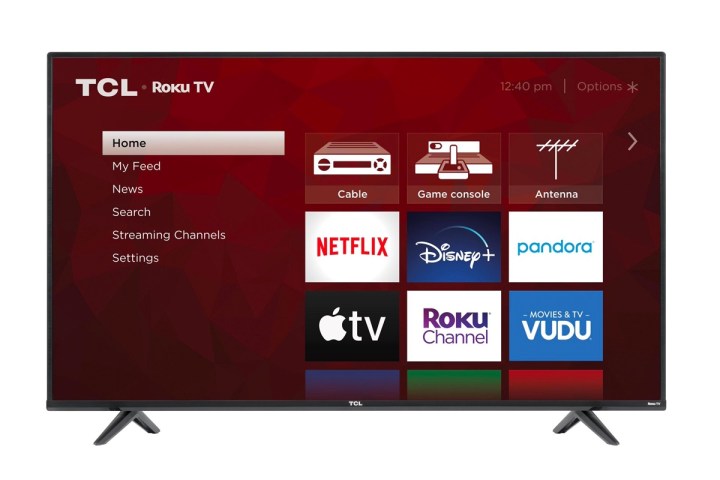Technology
TCL Prime Big Deal Days TV deals: TVs from $115


Update 09/30/24: As we begin covering the upcoming October Big Deal Days event from Amazon (October 8 and 9), we’re once again reminded that you can find many budget, yet quality, TVs from TCL that average viewers love. Right now, we’re just getting started, catching the first items that hit sales, and are excited to see how this space develops.
October Big Deal Days are approaching, meaning great deals from Amazon (who is the originator of the event) and other retailers trying to get a slice of the pie. While the best Big Deal Days deals are varied, covering everything from computers to furniture, we’re also finding plenty of good deals in niche categories to cover them by themselves. For example, we found enough to create an entire listing of Best Buy Big Deal Days TV deals in case you want to take advantage of your membership there, while we were also able to create an entire curated selection of Dell Big Deal Days deals if you like the brand. Here, we’re giving TCL the same treatment. The following are quality deals on products from the already budget TV brand.
TCL 32-inch Class 3-Series 1080p Roku TV — $115 $128 10% off

This is the kind of TV that you compare to a tablet not a normal TV. Why? It’s just 1080p and rather small. But imagine getting a smart screen that’s 32 inches diagonal to diagonal for just $115. It’s really difficult to picture, especially after comparing to the best tablet deals. If this is for you, you know who you are.
TCL 50-inch Class 4K Google TV — $198 $228 13% off

This is a cheap 4K TV with everything you need to enjoy it. It doesn’t have OLED or QLED tech, but it does have HDR, meaning there’ll be a slight color boost but not the brightness and contrast levels you could expect from a TV that cost 10X more. For the price, it really can’t be beat.
TCL 55-inch Class F-35 Series 4K Fire TV — $260 $330 21% off

A 2024 model with a hefty discount. This low-cost TV provides ALLM for low latency gaming, personal Bluetooth audio, DTS:X, and HDR10. It even has an enhanced dialogue mode for better voice clarity to make everything pop, even in movies and show with intense atmospheric sound.
TCL 65-inch Class S4 S-Class 4K Google TV — $360 $400 10% off

Despite the price, this TV has pretty much all of the features that you’ll need to be proud of a TV pick. It has ALLM for low input lag gaming, HDR PRO, motion rate 240 for great motion clarity, and even personal Bluetooth audio should you need it.
TCL 55-inch Class Q7 Q-Class QLED 4K Google TV — $500 $600 17% off

This TV is not for TV enthusiasts, at least according to our TCL Q7 QLED review. Luckily, it doesn’t have to be. It’s good for great contrast and gaming, but the nitty gritty that enthusiasts pay attention to might be lacking. To put it into perspective, our reviewer (Caleb Denison) imitated a potential average reader saying, “Man, that Caleb guy sure was going on about nothing. This TV looks great!” And at $500 you’ll likely agree.
TCL 75-inch Class Q6 Q-Class 4K QLED Google TV (2024) — $748 $1,100 32% off

Nearly a third off, a 2024 TV, QLED backlighting tech, and a huge 75 inch body. If it weren’t TCL, you would be expecting to pay a lot more for these stats, but right now it is a mere $748 if you pick it up while the deal lasts.
TCL 55-inch Class QM7 Mini LED Google TV (2024) — $700 $800 13% off

If you are interested in getting a mini-LED TV and, at the very least, trying it out for a spin, this is the deal to pick up. Bigger and higher quality mini-LED TVs will typically run at least a $1,000, after all, and this one usually runs $800. This is an excellent entry point.
TCL 85-inch Class QM8 Mini LED Google TV (2024) — $2,500 $3,000 20% off

An absolutely massive (the one in the image above is the 98-incher we looked at in our QM8 review) mini-LED with “massive appeal” as well. Caleb Denison, the same reviewer who was self-aware of the enthusiast vs average person issue when looking at the Q7 up above, actually says this TV is a recommend for 90% of people this year and that the “QM8 redefines what you should expect from a QLED TV” on the whole. This is an everybody TV, and for a limited time you can get it 20% off.
How to choose a TCL TV on Prime Day
TCL TVs are cheap but pull higher punches than their cost suggests, especially while on sale. If phrases like “local dimming zones” or “nits of brightness” mean little to you and you haven’t already developed expensive tastes, TCL TVs are the ones to buy. There is one point of strategy here, however: Spending even $100 to $200 more than you typically would on a TV on a for-sale TCL TV will likely give you a TV that will last you several years longer in terms of satisfaction and style. If you can’t at all afford it, at the very least try to go for a 4K TV.
However, even if you do have TV taste there are certainly things to enjoy about TCL TVs, especially the ones over the $750 to $1,000 price point. We can’t recommend the QM8 enough, for example, as a QLED for the masses. TCL is shaping up to be a big brand, securing a role as the king of budget TVs, but we’re also starting to see contenders for high marks.
How we chose these TCL TV Prime Day deals
Have we mentioned budget in this article yet? If you were to chart the price distribution of TVs in any of our guides, TV deals roundups, or other content, this article would likely have the largest skewing towards budget TVs in the bunch. That’s TCL’s specialty. And people — real, ordinary people that look at one TV day after day instead of a constant stream of TVs for evaluation — seem to love them, often rating them highly. The price to quality ratio is just that high. And so it goes with our picks for TCL TV Big Deal Days deals; we’re going after TVs that people like with prices that people love.
Once again, however, that isn’t to say that those wanting premium or large TVs should turn a blind eye to TCL deals. The difference is availability. Also note that when we look at premium TCL TVs, like the QM8, we’re still finding qualities that everyone will like. You won’t need a TV for gaming and another for movies, for instance. Plus, the price is still right, as we’re able to find large (over 15%) discounts on these high end TVs at this time.
Technology
Samsung Galaxy Buds FE drop to $50, an all-time low

Right now you can pick up Samsung’s stellar Galaxy Buds FE true wireless earbuds for $59.99, and that’s a very good price for a pair of true wireless earbuds that are as good as these ones are. Even at their full retail price of $99.99, the Galaxy Buds FE are a pretty good value. So it’s always going to be an incredible value when they’re priced this low.
This is the lowest we’ve ever seen the Galaxy Buds FE cost and it’s also an all-time low price based on price tracking data from Camel Camel Camel.

The Samsung Galaxy Buds FE are Samsung’s budget option of the Galaxy Buds and yet, they come with a lot of the same quality features. During our testing time we found that the earbuds had great battery life and a range of decent EQ options. They also come with balanced sound for an enjoyable, well-rounded listening experience no matter what type of music it is.
These also come with Active Noise Cancellation and that’s probably our favorite feature. Have you ever been on public transit, or on an airplane and you’re surrounded by noisy people? If you had these earbuds with ANC that wouldn’t be an issue. You could just pop them in, turn the ANC on, and block everyone else out. It’s excellent. And it makes a big difference in travel. I personally like to use it while I’m out shopping at the grocery store or other stores and block out the ambient noise of the store and other shoppers.
These come in two colors, Graphite and White, and both colors are on sale for the $59.99 price point.
Technology
Hori’s officially licensed Steam controller comes to the US on December 16

Hori is bringing its to the good ole US of A. The company , with an availability date of December 16. Preorders are open right now and the controller costs $60.
This Steam-focused gamepad was originally released back in October, but only in Japan. It boasts a big button to pull up the Steam menu and touch sensors on the joysticks for motion controls. It also ships with mappable back buttons. The gamepad connects to a computer, or a Steam Deck, via Bluetooth. To that end, it ships with a USB-A Bluetooth receiver.
Hori says the Steam controller will work for around 12 hours on a full charge, though it can operate while charging via USB cable. The controller menu in Steam also allows for making adjustments, like changing stick sensitivity and gyro controls.
There are a couple of slight omissions. The controller has no rumble functionality, nor does it boast a trackpad or a headphone jack. If you can get over those issues, this looks like a mighty fine way to work through that ever-growing Steam collection. Hori .
As for Valve, it discontinued . That gamepad was notable because it could be configured in a myriad of different ways .
Technology
Meet the startup that just won the Pentagon’s first AI defense contract

Join our daily and weekly newsletters for the latest updates and exclusive content on industry-leading AI coverage. Learn More
The Department of Defense has awarded its first generative AI defense contract to Jericho Security, marking a strategic shift in military cybersecurity. The $1.8 million Small Business Technology Transfer (STTR) Phase II contract, announced through AFWERX, tasks the New York-based startup with developing advanced cybersecurity solutions for the Department of the Air Force.
“This is one of the first generative AI contracts awarded in defense, marking a major milestone in how seriously our military is addressing AI-based threats,” Sage Wohns, CEO of Jericho Security, told VentureBeat in an exclusive interview
How AI-powered phishing attacks target military personnel
The company’s approach centers on simulating complex, multi-channel phishing attacks that mirror real-world scenarios. “In today’s landscape, phishing campaigns aren’t limited to just emails—they involve coordinated attempts across multiple platforms like text messages, phone calls, and even video calls,” Wohns explained, describing attacks that chain together multiple forms of communication to deceive targets.
What sets Jericho’s technology apart is its focus on human vulnerability — widely considered the weakest link in cybersecurity. The company claims that up to 95% of data breaches stem from human error. Their platform creates personalized security training programs based on individual risk profiles, using generative AI to simulate sophisticated attacks including deepfake impersonations and AI-generated malware.
Deepfake attacks and drone pilot targeting: The new frontier of military cybersecurity
The contract comes at a critical time, as military personnel face increasingly targeted attacks. “There was a highly publicized spear-phishing attack targeting Air Force drone pilots using fake user manuals,” Wohns revealed, highlighting how the company helped evaluate vulnerabilities through attack simulation and specialized training.
For a young company competing in the crowded cybersecurity market, landing a Defense Department contract represents a major validation. The deal positions Jericho Security to expand beyond its commercial roots into the lucrative government sector, where cybersecurity spending continues to grow amid escalating threats.
Military contracts often require stringent security measures. Wohns emphasized that Jericho maintains “military-grade cybersecurity standards” including end-to-end encryption and isolated secure environments for handling sensitive military data.
The next generation of AI defense: Predator and prey model
Unlike traditional cybersecurity approaches that react to known threats, Jericho Security employs what Wohns calls a “predator and prey” model. “We started with attack simulation, giving us a continuous stream of real-time data to enhance both offensive and defensive capabilities,” he said. This dual approach allows their AI systems to evolve alongside emerging threats rather than merely responding to them.
The Air Force contract, executed through AFWERX—the innovation arm of the Department of the Air Force—is part of a broader initiative to accelerate military adoption of private sector technology. AFWERX has awarded over 6,200 contracts worth more than $4.7 billion since 2019, working to strengthen the U.S. defense industrial base and speed up technology deployment.
Source link
Technology
Symbiotic Security helps developers find bugs as they code

Symbiotic Security, which is announcing a $3 million seed round today, watches over developers as they code and points out potential security issues in real time. Other companies do this, but Symbiotic also emphasizes the next step: teaching developers to avoid these bugs in the first place.
Ideally, this means developers will fix security bugs before they ever get into a code repository, which in turn should also speed up the overall development process. And since the developers get to learn on the job and in the environment they are already working in, they are far more likely to correctly implement the required changes. That’s more effective than making them sit through an annual security training in SuccessFactors.
The company, which launched earlier this year, released its MVP about a month ago, with a focus on infrastructure-as-code languages like Terraform. As Symbiotic co-founder and CEO Jerome Robert told me, the company did this to get an MVP out of the door and prove out its vision. Over time, the team plans to expand to the rest of the application stack and support languages like Python and JavaScript.

Robert noted that even the most developer-friendly security tools are still, at their core, tools for the security teams. “They are enabling the security teams to be better cops. They’re not tools that make the developers the good guys,” he said. “They are tools that allow security teams to send hundreds of messages all week long, saying, ‘You’ve made a mistake. You need to fix it.’”
Meanwhile, the developer constantly has to choose between fixing security issues and developing new features.
The idea behind Symbiotic Security is to nudge developers in the right direction, similar to the code completion tools they are already familiar with. Symbiotic, ideally, can help developers fix bugs in the inner loop, while they are still coding, and long before the continuous integration and delivery platforms start scanning the code for issues. Once that happens, the process slows down immediately, with Jira tickets and additional code review processes taking over.

This is also where Symbiotic goes a step further. “It would not be sufficient to just allow them to fix [the issues] and to detect it,” Robert explained. “We also need to train them on security — and developers love to train; it’s an absolute, 100% certain thing. However, security trainings are painful.”
For the developers, Robert argues that doing the training on the spot is something they can relate to. It’s focused on their immediate needs and not something that is abstract — and at just a few minutes, it’s short.
Right now, those training lessons and videos are pre-recorded, but over time, they could become more AI-driven, which would allow Symbiotic to make them even more relevant to the specific issues the developer is working on.
There’s also another interesting twist here. To best train a model to automatically fix security issues, you need a corpus of code with security bugs and the fixed versions of those code snippets. Since Symbiotic is seeing the issue and then telling the developer how to fix it, it could ideally create a high-quality dataset for building a remediation model. For now, that’s a long-term project, though.
Symbiotic is backed by the likes of Lerer Hippeau, Axeleo Capital, and Factorial Capital. “Jerome and co-founder Edouard Viot have a deep understanding of the problems underlying traditional code security and demonstrated remarkable foresight with their approach to addressing the growing demand for shift-left security solutions,” said Graham Brown, managing partner, Lerer Hippeau. “Symbiotic has the potential to transform the industry, empowering developers and security teams alike.”
Science & Environment
Jim Cramer is encouraged by updates on 3 stocks that indicate further upside ahead
Technology
Kia’s rugged EV concepts are standouts at 2024’s SEMA conference

The Specialty Equipment Market Association, or SEMA, held its annual conference in Las Vegas this week. Billed as one of the biggest car shows in the world, the event typically brings together more than 135,000 attendees in the automotive aftermarket industry to see the newest trends in vehicle repairs and modifications.
And while there weren’t as many electric vehicle concepts and one-offs as years past — after all, we’re in the midst of a historic transition in the auto industry that is equal parts momentous and slower going than we expected — there were still a handful of interesting plug-in models worth highlighting.
The Stellantis-owned parts and accessories division brought a number of compelling concepts to this year’s SEMA show. But none of them were as effortlessly cool as this 1967 Plymouth GTX “electromod.” This one-of-a-kind restomod is based on the — you guessed it — 1967 Plymouth GTX muscle car. And this new conversion is a taste of what’s to come from the world of electric conversions of classic cars.
Mopar wanted to show what was possible — a “potential future,” the company put it in its press release — using Mopar’s e-Crate propulsion systems. Classic car enthusiasts could pick up one of these conversion kits to transform a vintage muscle car or truck into a battery-electric vehicle.
Mopar tweaked the Plymouth’s exterior to include a carbon-fiber front splitter and custom low-profile rear spoiler. The company also paid homage to the flip-top fuel caps of the 1960s and ’70s by updating its function as a charge-port door.
Kia’s spacious three-row EV9 got a rugged facelift for SEMA, transforming into a new adventure-themed concept aptly named ADVNTR. Appearing alongside it is the WKNDR concept, based on Kia’s Platform Beyond Vehicle (PBV) modular concept that was first revealed at CES earlier this year.
Together, both concepts are designed for off-the-beaten-path excursions, with custom exterior designs aimed at rock climbing or river fording. The EV9-based ADVNTR is raised three inches more than the standard EV9, along with rugged wheel and tire combinations. Meanwhile, the WKNDR is also perched on off-road-capable tires and features a customizable interior for an endless variety of outdoor adventures.
Kia highlights several modular features: an onboard compressor to handle inflation, from adjusting tire pressure to inflating air mattresses for camping; a mobile pantry for outdoor cooking; and built-in solar panels and hydro-turbine wheels that can recharge the batteries.
-

 Science & Environment2 months ago
Science & Environment2 months agoHow to unsnarl a tangle of threads, according to physics
-

 Technology1 month ago
Technology1 month agoIs sharing your smartphone PIN part of a healthy relationship?
-

 Science & Environment2 months ago
Science & Environment2 months ago‘Running of the bulls’ festival crowds move like charged particles
-

 Science & Environment2 months ago
Science & Environment2 months agoHyperelastic gel is one of the stretchiest materials known to science
-

 Technology2 months ago
Technology2 months agoWould-be reality TV contestants ‘not looking real’
-

 Science & Environment1 month ago
Science & Environment1 month agoX-rays reveal half-billion-year-old insect ancestor
-

 Science & Environment2 months ago
Science & Environment2 months agoMaxwell’s demon charges quantum batteries inside of a quantum computer
-

 Money1 month ago
Money1 month agoWetherspoons issues update on closures – see the full list of five still at risk and 26 gone for good
-

 Science & Environment2 months ago
Science & Environment2 months agoSunlight-trapping device can generate temperatures over 1000°C
-

 Science & Environment2 months ago
Science & Environment2 months agoPhysicists have worked out how to melt any material
-

 Sport1 month ago
Sport1 month agoAaron Ramsdale: Southampton goalkeeper left Arsenal for more game time
-

 Technology1 month ago
Technology1 month agoGmail gets redesigned summary cards with more data & features
-

 Football1 month ago
Football1 month agoRangers & Celtic ready for first SWPL derby showdown
-

 MMA1 month ago
MMA1 month ago‘Dirt decision’: Conor McGregor, pros react to Jose Aldo’s razor-thin loss at UFC 307
-

 Science & Environment2 months ago
Science & Environment2 months agoLaser helps turn an electron into a coil of mass and charge
-

 Technology1 month ago
Technology1 month agoUkraine is using AI to manage the removal of Russian landmines
-

 News1 month ago
News1 month agoWoman who died of cancer ‘was misdiagnosed on phone call with GP’
-

 Sport1 month ago
Sport1 month agoBoxing: World champion Nick Ball set for Liverpool homecoming against Ronny Rios
-

 Technology1 month ago
Technology1 month agoEpic Games CEO Tim Sweeney renews blast at ‘gatekeeper’ platform owners
-

 Science & Environment2 months ago
Science & Environment2 months agoA new kind of experiment at the Large Hadron Collider could unravel quantum reality
-

 Technology1 month ago
Technology1 month agoRussia is building ground-based kamikaze robots out of old hoverboards
-

 Technology1 month ago
Technology1 month agoSamsung Passkeys will work with Samsung’s smart home devices
-

 MMA1 month ago
MMA1 month agoDana White’s Contender Series 74 recap, analysis, winner grades
-

 News1 month ago
News1 month ago‘Blacks for Trump’ and Pennsylvania progressives play for undecided voters
-

 Science & Environment2 months ago
Science & Environment2 months agoQuantum ‘supersolid’ matter stirred using magnets
-

 Science & Environment2 months ago
Science & Environment2 months agoLiquid crystals could improve quantum communication devices
-
Business1 month ago
how UniCredit built its Commerzbank stake
-

 Technology1 month ago
Technology1 month agoMicrosoft just dropped Drasi, and it could change how we handle big data
-

 MMA4 weeks ago
MMA4 weeks ago‘Uncrowned queen’ Kayla Harrison tastes blood, wants UFC title run
-

 Science & Environment2 months ago
Science & Environment2 months agoWhy this is a golden age for life to thrive across the universe
-

 News1 month ago
News1 month agoRwanda restricts funeral sizes following outbreak
-

 Technology1 month ago
Technology1 month agoCheck, Remote, and Gusto discuss the future of work at Disrupt 2024
-

 News1 month ago
News1 month agoNavigating the News Void: Opportunities for Revitalization
-

 Sport1 month ago
Sport1 month ago2024 ICC Women’s T20 World Cup: Pakistan beat Sri Lanka
-

 TV1 month ago
TV1 month agoসারাদেশে দিনব্যাপী বৃষ্টির পূর্বাভাস; সমুদ্রবন্দরে ৩ নম্বর সংকেত | Weather Today | Jamuna TV
-

 MMA1 month ago
MMA1 month agoPereira vs. Rountree prediction: Champ chases legend status
-

 News1 month ago
News1 month agoMassive blasts in Beirut after renewed Israeli air strikes
-

 Entertainment1 month ago
Entertainment1 month agoBruce Springsteen endorses Harris, calls Trump “most dangerous candidate for president in my lifetime”
-

 Technology1 month ago
Technology1 month agoWhy Machines Learn: A clever primer makes sense of what makes AI possible
-

 Technology1 month ago
Technology1 month agoMicrophone made of atom-thick graphene could be used in smartphones
-

 Business1 month ago
Business1 month agoWater companies ‘failing to address customers’ concerns’
-

 News1 month ago
News1 month agoCornell is about to deport a student over Palestine activism
-

 Business1 month ago
Business1 month agoWhen to tip and when not to tip
-

 Sport1 month ago
Sport1 month agoWXV1: Canada 21-8 Ireland – Hosts make it two wins from two
-

 MMA1 month ago
MMA1 month agoKayla Harrison gets involved in nasty war of words with Julianna Pena and Ketlen Vieira
-

 Football1 month ago
Football1 month ago'Rangers outclassed and outplayed as Hearts stop rot'
-

 News1 month ago
News1 month agoHull KR 10-8 Warrington Wolves – Robins reach first Super League Grand Final
-

 Science & Environment2 months ago
Science & Environment2 months agoQuantum forces used to automatically assemble tiny device
-

 Science & Environment2 months ago
Science & Environment2 months agoITER: Is the world’s biggest fusion experiment dead after new delay to 2035?
-

 News2 months ago
News2 months ago▶️ Hamas in the West Bank: Rising Support and Deadly Attacks You Might Not Know About
-

 Science & Environment2 months ago
Science & Environment2 months agoNuclear fusion experiment overcomes two key operating hurdles
-
Business1 month ago
Top shale boss says US ‘unusually vulnerable’ to Middle East oil shock
-

 Technology1 month ago
Technology1 month agoSingleStore’s BryteFlow acquisition targets data integration
-

 Sport1 month ago
Sport1 month agoChina Open: Carlos Alcaraz recovers to beat Jannik Sinner in dramatic final
-

 Football1 month ago
Football1 month agoWhy does Prince William support Aston Villa?
-

 News1 month ago
News1 month ago▶ Hamas Spent $1B on Tunnels Instead of Investing in a Future for Gaza’s People
-

 Technology1 month ago
Technology1 month agoMusk faces SEC questions over X takeover
-

 Sport1 month ago
Sport1 month agoPremiership Women’s Rugby: Exeter Chiefs boss unhappy with WXV clash
-

 Sport1 month ago
Sport1 month agoShanghai Masters: Jannik Sinner and Carlos Alcaraz win openers
-

 Sport1 month ago
Sport1 month agoCoco Gauff stages superb comeback to reach China Open final
-

 Science & Environment2 months ago
Science & Environment2 months agoA slight curve helps rocks make the biggest splash
-

 Technology2 months ago
Technology2 months agoMeta has a major opportunity to win the AI hardware race
-

 Womens Workouts1 month ago
Womens Workouts1 month ago3 Day Full Body Women’s Dumbbell Only Workout
-

 Technology1 month ago
Technology1 month agoUniversity examiners fail to spot ChatGPT answers in real-world test
-
Business1 month ago
Bank of England warns of ‘future stress’ from hedge fund bets against US Treasuries
-

 Technology1 month ago
Technology1 month agoLG C4 OLED smart TVs hit record-low prices ahead of Prime Day
-

 MMA1 month ago
MMA1 month ago‘I was fighting on automatic pilot’ at UFC 306
-

 News1 month ago
News1 month agoGerman Car Company Declares Bankruptcy – 200 Employees Lose Their Jobs
-

 Sport1 month ago
Sport1 month agoWales fall to second loss of WXV against Italy
-
Business1 month ago
DoJ accuses Donald Trump of ‘private criminal effort’ to overturn 2020 election
-
Business1 month ago
Sterling slides after Bailey says BoE could be ‘a bit more aggressive’ on rates
-

 TV1 month ago
TV1 month agoTV Patrol Express September 26, 2024
-

 Sport1 month ago
Sport1 month agoSturm Graz: How Austrians ended Red Bull’s title dominance
-

 Money4 weeks ago
Money4 weeks agoTiny clue on edge of £1 coin that makes it worth 2500 times its face value – do you have one lurking in your change?
-

 Science & Environment2 months ago
Science & Environment2 months agoTime travel sci-fi novel is a rip-roaringly good thought experiment
-

 MMA1 month ago
MMA1 month agoPennington vs. Peña pick: Can ex-champ recapture title?
-

 MMA1 month ago
MMA1 month agoKetlen Vieira vs. Kayla Harrison pick, start time, odds: UFC 307
-

 Technology1 month ago
Technology1 month agoThe best shows on Max (formerly HBO Max) right now
-

 Technology1 month ago
Technology1 month agoIf you’ve ever considered smart glasses, this Amazon deal is for you
-

 Technology1 month ago
Technology1 month agoJ.B. Hunt and UP.Labs launch venture lab to build logistics startups
-
Travel1 month ago
World of Hyatt welcomes iconic lifestyle brand in latest partnership
-

 Technology1 month ago
Technology1 month agoQuoroom acquires Investory to scale up its capital-raising platform for startups
-
Business1 month ago
The search for Japan’s ‘lost’ art
-

 Sport1 month ago
Sport1 month agoNew Zealand v England in WXV: Black Ferns not ‘invincible’ before game
-

 Sport1 month ago
Sport1 month agoMan City ask for Premier League season to be DELAYED as Pep Guardiola escalates fixture pile-up row
-

 News2 months ago
News2 months ago▶️ Media Bias: How They Spin Attack on Hezbollah and Ignore the Reality
-

 Science & Environment2 months ago
Science & Environment2 months agoNerve fibres in the brain could generate quantum entanglement
-

 Technology1 month ago
Technology1 month agoAmazon’s Ring just doubled the price of its alarm monitoring service for grandfathered customers
-

 News1 month ago
News1 month agoTrump returns to Pennsylvania for rally at site of assassination attempt
-

 Technology4 weeks ago
Technology4 weeks agoThe FBI secretly created an Ethereum token to investigate crypto fraud
-

 Science & Environment2 months ago
Science & Environment2 months agoHow to wrap your mind around the real multiverse
-

 Business1 month ago
Business1 month agoStocks Tumble in Japan After Party’s Election of New Prime Minister
-

 MMA1 month ago
MMA1 month agoHow to watch Salt Lake City title fights, lineup, odds, more
-

 Technology1 month ago
Technology1 month agoTexas is suing TikTok for allegedly violating its new child privacy law
-

 Technology1 month ago
Technology1 month agoOpenAI secured more billions, but there’s still capital left for other startups
-
Business1 month ago
‘Let’s be more normal’ — and rival Tory strategies
-

 News1 month ago
News1 month agoHarry vs Sun publisher: ‘Two obdurate but well-resourced armies’
-

 News1 month ago
News1 month agoFamily plans to honor hurricane victim using logs from fallen tree that killed him
-

 Money1 month ago
Money1 month agoPub selling Britain’s ‘CHEAPEST’ pints for just £2.60 – but you’ll have to follow super-strict rules to get in
-

 Sport1 month ago
Sport1 month agoURC: Munster 23-0 Ospreys – hosts enjoy second win of season


You must be logged in to post a comment Login